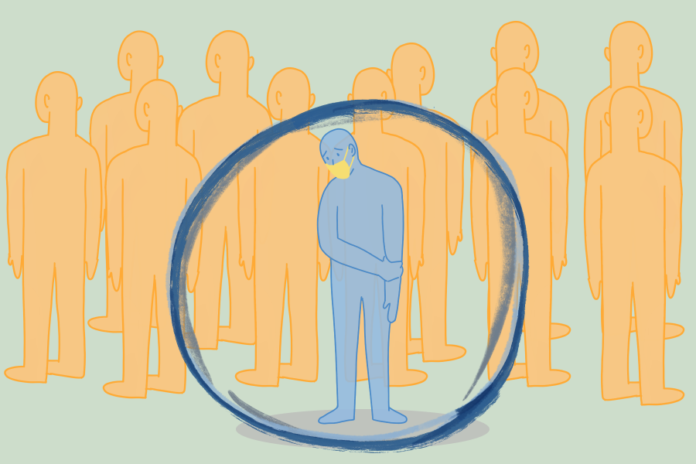UC Davis infectious disease expert explains why the omicron variant is so contagious and how it is expected to spread in Davis and around the U.S.
By MAYA SHYDLOWSKI — features@theaggie.org
Students shouldn’t be ashamed if they test positive for COVID-19 in the coming month, according to UC Davis infectious disease expert Dr. Dean Blumberg. COVID-19 cases are urging across the U.S., including in YOLO county, fuelled by the highly contagious omicron variant. Blumberg said that the rate of COVID-19 infection of the coronavirus is the highest it has ever been in the country, and it is projected to keep rising until its estimated peak in early February, so if you test positive, know that you are definitely not alone.
“A lot of the time when people do test positive, and they have to tell the people who they’ve had contact with, they’re embarrassed about it,” Blumberg said. “They feel bad that they might have exposed other people. This is such an incredibly infectious and transmissible strain that when people do test positive and they let other people know, they’re really being heroes. They are being brave. They shouldn’t be ashamed.”
Even some students who have social distanced, masked and taken the safety precautions recommended by the Centers for Disease Control and Prevention, like fourth-year managerial economics major John Giovannoni, are testing positive during this recent surge. When Giovannoni returned to Davis after winter break and got his routine COVID-19 test to allow him back on campus, he unexpectedly tested positive.
“I have always been extremely cautious with COVID, was vaccinated twice as soon as possible and got the Moderna booster in November,” Giovannoni said. “Over the holiday break, I continued to stay inside when I was home to make sure that none of my family would get infected, so we didn’t have to ruin Christmas.”
Despite many people’s best efforts to be safe, stories like Giovannoni’s are not uncommon. Although a lot is still unknown about the rapidly spreading omicron variant, Dr. Blumberg shared why scientists believe that it is causing such a steep surge. He said that the strain is far more transmissible than previous variants, in part because it has 50 more mutations than the original strain, which allow it to bypass developed antibodies from vaccination or previous infection. He also said that the omicron variant is believed to be two to five times more transmissible than the Delta variant. Blumberg compared the recent rate of infection to those of last winter, during another national COVID-19 surge.
“For the surge that we saw last winter, in December and January, the model suggested that there were about 80,000 infections per day in California,” Blumberg said. “What we’re seeing now is over 120,000 cases a day, and it’s going to get even worse, because the model suggests that it’s going to peak at over 300,000 [cases] a day in early February. That’s about four times higher than the largest surge that we had last year.”
Despite these large statistics, Blumberg said that one silver lining in this surge is that the omicron variant causes a generally milder disease than previous variants.
“What’s been found in the laboratory is that the omicron variant results in about 70 times higher concentrations of virus in upper respiratory airway cells, but about 10 times lower concentrations in lung tissues,” Blumberg said. “That suggests that the reason that it’s more transmissible is the higher concentrations that’s favorable for spread in the upper respiratory tract, but then it doesn’t go to the lower respiratory tract.”
Because the omicron variant seems to inhabit the lung tissue less, it is less likely to cause severe respiratory illnesses like pneumonia. Blumberg mentioned that a study in the U.K. showed that this variant has resulted in fewer cases that end up in the emergency room or require hospitalization at all, which could be indicative of a lower percentage of people who get sick in the U.S. needing hospitalization — though he mentioned that it is impossible to predict for certain how U.S. hospitals will be affected in the coming weeks.
Davis has seen this sharp rise in cases over the past month, during which the positivity rate of Healthy Davis Together testing sites has been around 10% — the highest that it has been thus far throughout the pandemic. UC Davis’s asymptomatic testing during week one of winter quarter also detected its highest positivity rate to date, at over 4%, prompting the campus to extend online instruction until Jan. 28. Giovannoni said that after Jan. 28, he hopes that accommodations will be made, both for students who want to be on campus, and those who do not feel safe or comfortable to do so yet.
“Moving forward, I hope there is some sort of hybrid option for those that want to go to class and ones that are sick or don’t feel comfortable,” Giovannoni said. “Since I’ve been highly cautious compared to most and I still caught COVID, I don’t think it’s going to go away all that soon, but I’m glad it appears to be mild from my experience and stories from others.”
Written by: Maya Shydlowski — features@theaggie.org





